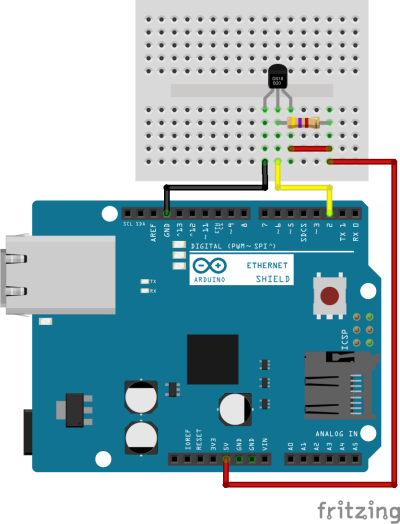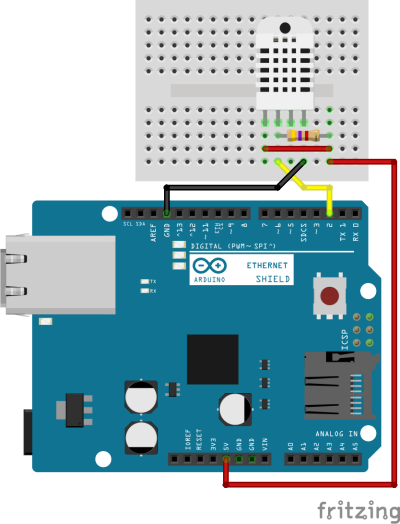zarizeni:arduino
Obsah
Návody pro Arduino
Následující návody přichystal Petr Domorázek, petr@domorazek.cz, http://domorazek.cz/
Arduino UNO + Ethernet Shield (1-Wire / DS18B20)
Pro správnou funkci změňte adresu serveru a GUID dle nastavení vašeho účtu na Tmep.cz. Při připojení více zařízení se stejným kódem, nezapomeňte u dalších zařízení změnit i MAC. Příklad předpokládá přiřazení IP konfigurace z DHCP serveru (z routeru).
- tmep.cz_test_18b20.ino
/* Simple sketch for sending data to the TMEP.cz This sketch connects to a a web server and makes a request using a Wiznet Ethernet shield. You can use the Arduino Ethernet shield, or the Adafruit Ethernet shield, either one will work, as long as it's got a Wiznet Ethernet module on board. Uses code examples: http://www.arduino.cc/en/Tutorial/WebClientRepeating http://www.arduino.cc/en/Tutorial/DhcpAddressPrinter */ #include <SPI.h> #include <Ethernet.h> #include <OneWire.h> #include <DallasTemperature.h> // Data wire is plugged into port 2 on the Arduino #define ONE_WIRE_BUS 2 // Setup a oneWire instance to communicate with any OneWire devices (not just Maxim/Dallas temperature ICs) OneWire oneWire(ONE_WIRE_BUS); // Pass our oneWire reference to Dallas Temperature. DallasTemperature sensors(&oneWire); // assign a MAC address for the ethernet controller. // fill in your address here: byte mac[] = { 0xDE, 0xAD, 0xBE, 0xEF, 0xFE, 0xED }; // initialize the library instance: EthernetClient client; char server[] = "tst.tmep.cz"; // domain.tmep.cz char guid[] = "12345678"; // guid unsigned long lastConnectionTime = 0; // last time you connected to the server, in milliseconds const unsigned long postingInterval = 60L * 1000L; // delay between updates, in milliseconds // the "L" is needed to use long type numbers void setup() { // start serial port: Serial.begin(9600); while (!Serial) { ; // wait for serial port to connect. Needed for native USB port only } // give the ethernet module time to boot up: delay(1000); // start the Ethernet connection: if (Ethernet.begin(mac) == 0) { Serial.println("Failed to configure Ethernet using DHCP"); // no point in carrying on, so do nothing forevermore: for (;;) ; } printIPAddress(); sensors.begin(); } void loop() { switch (Ethernet.maintain()) { case 1: //renewed fail Serial.println("Error: renewed fail"); break; case 2: //renewed success Serial.println("Renewed success"); //print your local IP address: printIPAddress(); break; case 3: //rebind fail Serial.println("Error: rebind fail"); break; case 4: //rebind success Serial.println("Rebind success"); //print your local IP address: printIPAddress(); break; default: //nothing happened break; } // if there's incoming data from the net connection. // send it out the serial port. This is for debugging // purposes only: if (client.available()) { char c = client.read(); //Serial.write(c); } // if ten seconds have passed since your last connection, // then connect again and send data: if (millis() - lastConnectionTime > postingInterval) { httpRequest(); } } // this method makes a HTTP connection to the server: void httpRequest() { // close any connection before send a new request. // This will free the socket on the WiFi shield client.stop(); // call sensors.requestTemperatures() to issue a global temperature // request to all devices on the bus Serial.print("Requesting temperatures..."); sensors.requestTemperatures(); // Send the command to get temperatures Serial.println("DONE"); // After we got the temperatures, we can print them here. // We use the function ByIndex, and as an example get the temperature from the first sensor only. Serial.print("Temperature for the device 1 (index 0) is: "); float t = sensors.getTempCByIndex(0); // Read temperature in "t" variable if (t == -127.00) { // If you have connected it wrong, Dallas read this temperature! :) Serial.println("Error!"); return; } Serial.println(t); // if there's a successful connection: if (client.connect(server, 80)) { Serial.print("connecting..."); // send the HTTP GET request: client.print("GET /?"); client.print(guid); client.print("="); client.print(t); client.println(" HTTP/1.1"); client.print("Host: "); client.println(server); client.println("User-Agent: arduino-ethernet"); client.println("Connection: close"); client.println(); Serial.println(" done."); // note the time that the connection was made: lastConnectionTime = millis(); } else { // if you couldn't make a connection: Serial.println(" connection failed"); } } void printIPAddress() { Serial.print("My IP address: "); for (byte thisByte = 0; thisByte < 4; thisByte++) { // print the value of each byte of the IP address: Serial.print(Ethernet.localIP()[thisByte], DEC); Serial.print("."); } Serial.println(); }
Arduino UNO + Ethernet Shield (DHT22)
- tmep.cz_test_dht.ino
/* Simple sketch for sending data to the TMEP.cz This sketch connects to a a web server and makes a request using a Wiznet Ethernet shield. You can use the Arduino Ethernet shield, or the Adafruit Ethernet shield, either one will work, as long as it's got a Wiznet Ethernet module on board. Uses code examples: http://www.arduino.cc/en/Tutorial/WebClientRepeating http://www.arduino.cc/en/Tutorial/DhcpAddressPrinter */ #include <SPI.h> #include <Ethernet.h> #include <DHT.h> #define DHTPIN 2 // Data wire is plugged into port 2 on the Arduino // Uncomment whatever type you're using! //#define DHTTYPE DHT11 // DHT 11 #define DHTTYPE DHT22 // DHT 22 (AM2302), AM2321 //#define DHTTYPE DHT21 // DHT 21 (AM2301) // initialize DHT sensor. DHT dht(DHTPIN, DHTTYPE); // assign a MAC address for the ethernet controller. // fill in your address here: byte mac[] = { 0xDE, 0xAD, 0xBE, 0xEF, 0xFE, 0xED }; // initialize the library instance: EthernetClient client; char server[] = "tst.tmep.cz"; // domain.tmep.cz char guid[] = "12345678"; // guid unsigned long lastConnectionTime = 0; // last time you connected to the server, in milliseconds const unsigned long postingInterval = 60L * 1000L; // delay between updates, in milliseconds // the "L" is needed to use long type numbers void setup() { // start serial port: Serial.begin(9600); while (!Serial) { ; // wait for serial port to connect. Needed for native USB port only } // give the ethernet module time to boot up: delay(1000); // start the Ethernet connection: if (Ethernet.begin(mac) == 0) { Serial.println("Failed to configure Ethernet using DHCP"); // no point in carrying on, so do nothing forevermore: for (;;) ; } printIPAddress(); dht.begin(); } void loop() { switch (Ethernet.maintain()) { case 1: //renewed fail Serial.println("Error: renewed fail"); break; case 2: //renewed success Serial.println("Renewed success"); //print your local IP address: printIPAddress(); break; case 3: //rebind fail Serial.println("Error: rebind fail"); break; case 4: //rebind success Serial.println("Rebind success"); //print your local IP address: printIPAddress(); break; default: //nothing happened break; } // if there's incoming data from the net connection. // send it out the serial port. This is for debugging // purposes only: if (client.available()) { char c = client.read(); //Serial.write(c); } // if ten seconds have passed since your last connection, // then connect again and send data: if (millis() - lastConnectionTime > postingInterval) { httpRequest(); } } // this method makes a HTTP connection to the server: void httpRequest() { // close any connection before send a new request. // This will free the socket on the WiFi shield client.stop(); // Read temperature float h = dht.readHumidity(); // Read temperature as Celsius (the default) float t = dht.readTemperature(); // Check if any reads failed and exit early (to try again). if (isnan(h) || isnan(t)) { Serial.println("Failed to read from DHT sensor!"); return; } Serial.print("Temperature: "); Serial.print(t); Serial.print("\t Humidity: "); Serial.println(h); // if there's a successful connection: if (client.connect(server, 80)) { Serial.print("connecting..."); // send the HTTP GET request: client.print("GET /?"); client.print(guid); client.print("="); client.print(t); client.print("&humV="); client.print(h); client.println(" HTTP/1.1"); client.print("Host: "); client.println(server); client.println("User-Agent: arduino-ethernet"); client.println("Connection: close"); client.println(); Serial.println(" done."); // note the time that the connection was made: lastConnectionTime = millis(); } else { // if you couldn't make a connection: Serial.println(" connection failed"); } } void printIPAddress() { Serial.print("My IP address: "); for (byte thisByte = 0; thisByte < 4; thisByte++) { // print the value of each byte of the IP address: Serial.print(Ethernet.localIP()[thisByte], DEC); Serial.print("."); } Serial.println(); }

